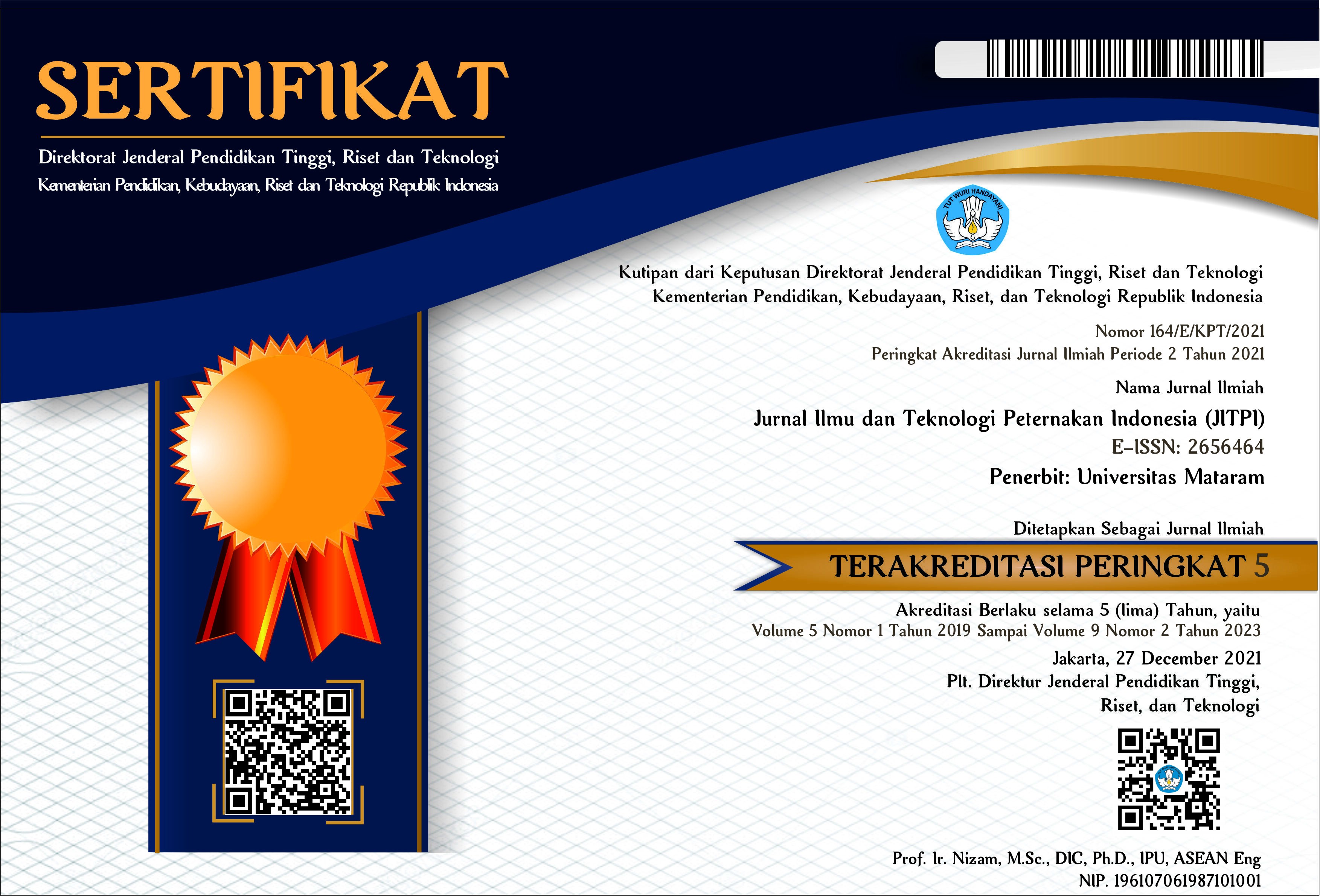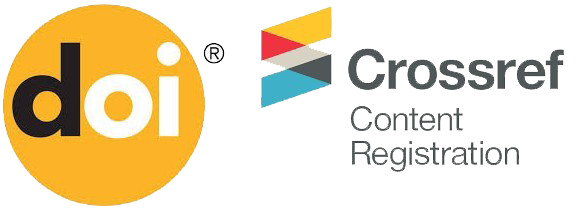About the Journal
JURNAL ILMU DAN TEKNOLOGI PETERNAKAN INDONESIA (JITPI) INDONESIAN JOURNAL OF ANIMAL SCIENCE AND TECHNOLOGY
Focus and Scope
The aim:
Jurnal Ilmu dan Teknologi Peternakan Indonesia (JITPI) Indonesian Journal of Animal Science and Technology is a scientific journal as a forum for communication in the study of theory and application in Animal Husbandry Contains scientific texts in the field of animal science and technology covering the genetics of livestock, livestock nutrition, livestock physiology, livestock production, socio-economic livestock, livestock development policy, livestock health, livestock processing technology, and animal husbandry biotechnology. Articles are considered to be loaded are in the form of research or scientific simulations that have never been published or are waiting for publishing in other publications. JITPI Journal publishes two times a year in June and December. Our publication is an open access journal so that it is free of charge unless the author(s) need the printed version.
Scope:
Contains scientific texts in the field of animal science and technology covering the genetics of livestock, livestock nutrition, livestock physiology, livestock production, socio-economic livestock, livestock development policy, livestock health, livestock processing technology, and animal husbandry biotechnology.
Section Policies
Articles
Peer Review Process
» Peer Review Process
Every submitted article is independently reviewed by at least a double-blind review (peer-reviewers). The decision for publication, amendment, or rejection is based upon their reports/recommendations. After being reviewed, there will be four kinds of editor decision based on the reviewers’ recommendation:
- Accept Submission: The submission will be accepted without revisions.
- Revisions Required [Minor Revision]: The submission will be accepted after minor changes have been made.
- Resubmit for Review [Mayor Revision]: The submission needs to be re-worked, but with significant changes, it may be accepted. It will require a second round of review, however.
- Decline Submission: The submission will not be published in the journal.
» Article Revision
The articles sent back to the authors for revision should be returned to the editor without delay. The revised article returned later than 10 days will be considered a New Submissions. The revised article can be sent to the editorial through the Online Submission Interface.
Publication Frequency
JITPI : Jurnal Ilmu Dan Teknologi Peternakan Indonesia (Indonesian Journal of Animal Science and Technology) is published twice a year, June and December. Each issue number is 5-7 article titles.
Open Access Policy

JITPI : Jurnal Ilmu Dan Teknologi Peternakan Indonesia (Indonesian Journal of Animal Science and Technology) is an open-access journal that provides immediate, worldwide, barrier-free access to the full text of all published articles without charge readers or their institutions for access. Readers have the right to read, download, copy, distribute, print, search, or link to the full texts of all articles in JITPI : Jurnal Ilmu Dan Teknologi Peternakan Indonesia (Indonesian Journal of Animal Science and Technology). This journal provides immediate open access to its content on the principle that making research freely available to the public supports a greater global exchange of knowledge.
Archiving
This journal utilizes the LOCKSS system to create a distributed archiving system among participating libraries and permits those libraries to create permanent archives of the journal for purposes of preservation and restoration. More...
Author Fees
This journal charges the following author fees.
Article Submission: 0.00 IDR
Authors are required to pay an Article Submission Fee as part of the submission process to contribute to review costs.
Article Publication: 33 USD
This journal charges the article publication fee for supporting the cost of wide-open access dissemination of research results, managing the various costs associated with handling and editing of the submitted manuscripts, and the journal management and publication in general, the authors or the author's institution is requested to pay a publication fee for each article accepted. The fee covers:
Submissions
- Online Submissions
- Author Guidelines
- Privacy Statement
Online Submissions
Already have a Username/Password for Jurnal Ilmu Dan Teknologi Peternakan Indonesia (JITPI) Indonesian Journal of Animal Science and Technology? Go to Login Need a Username/Password? Go to Registration. Registration and login are required to submit items online and to check the status of current submissions.
Author Guidelines
- Manuscript templates can be downloaded here.
- Authors Guidelines can be downloaded here.
- Author Stetement Form can be downloaded here.
Intruction to Author Jurnal Ilmu dan teknologi Peternakan Indonesia (JITPI) Indonesian Journal of Animal Science
GENERAL INFORMATION
- Manuscripts must be original, have not been published previously in any scientific journal, that manuscripts are not being submitted for publication elsewhere, and will not be submitted to any media during the review process, unless the authors have officially withdrawn the manuscripts from Jurnal Ilmu dan Teknologi Peternakan Indonesia (JITPI). The statement must be stated in a statement of originality and copyright release this form (click this link).
- Manuscripts submitted are research topics which have no conflict with bioethical research.
- Manuscripts encompasses a broad range of research topics in animal sciences: Breeding and Genetics, Reproduction and Physiology, Animal Nutrition, Feed Sciences, Agrostology, Animal Products, Food Processing and Technology, Biotechnology, Behaviour, Animal Welfare, Health, Livestock Farming System, Livestock and Climate Change, Socio-economic, and Policy.
- The journal is published 2 (two) times a year, i.e., June, and December.
MANUSCRIPT FILE
- Manuscripts are written in Indonesian or English and used standard scientific usage. Authors whose first language is not English should consult the manuscript with English editing service before submit it to Jurnal Ilmu Dan Teknologi Peternakan Indonesia (JITPI) Indonesian Journal of Animal Science and Technology
- Manuscripts should be prepared in Microsoft Word format, except for Graphs using Microsoft Excel program and Figures using JPEG or PDF format.
- Manuscripts should be typed using Times New Roman fonts at 12 points.
- Manuscripts should be typed double spaced except for Title, Tables, Title of Graphs/Figures, and appendix typed single spaced. Manuscripts are prepared in A4 paper, margins on all four sides are 3 cm, and total number of pages is 12-20.
- Tables, Graphs, and Figures should be placed after the References
- Use page numbers and line numbers.
- Manuscripts content should be arranged as the following order: Title, Name of the author(s) and their institutions, Abstract, Introduction, Methods (for Socio-Economic), Materials and Methods (for non Socio-Economic), Results, Discussion, Conclusion, Conflict of Interest, Acknowledgment (if any), References.
- Manuscript and Author Stetement form should be submitted electronically through online system: jitpi.unram.ac.id. Authors are unable to submit electronically could send the files to email: jitpi-faterna@unram.ac.id
Submission Preparation Checklist
As part of the submission process, authors are required to check off their submission's compliance with all of the following items, and submissions may be returned to authors that do not adhere to these guidelines.
- The submission has not been previously published, nor is it before another journal for consideration (or an explanation has been provided in Comments to the Editor).
- The submission file is in OpenOffice, Microsoft Word, RTF, or WordPerfect document file format.
- Where available, URLs for the references have been provided.
- The text is single-spaced; uses a 12-point font; employs italics, rather than underlining (except with URL addresses); and all illustrations, figures, and tables are placed within the text at the appropriate points, rather than at the end.
- The text adheres to the stylistic and bibliographic requirements outlined in the author guidelines , which is found in About the Journal.
- If submitting to a peer-reviewed section of the journal, the instructions in Ensuring a Blind Review have been followed.
Privacy Statement
The names and email addresses entered in this journal site will be used exclusively for the stated purposes of this journal and will not be made available for any other purpose or to any other party.
Editor Feedback
"Pointing out the specifics about flaws in the papers structure is paramount. Are methods valid, is data clearly presented, and are conclusions supported by data? (Editor feedback)
If an editor can read your comments and understand clearly the basis for your recommendation, then you have written a helpful review. (Editor feedback)
Publication Ethics
Ethic statements of Jurnal Ilmu Dan Teknologi Peternakan Indonesia (JITPI) Indonesian Journal of Animal Science and Technology are based on COPE’s Best Practice Guidelines for Journal Editors.

Publication and Authorship
- All submitted papers are subject to a strict peer-review process by at least two reviewers that are experts in the area of the particular paper.
- Review processes are double-blind peer review.
- The factors taken into account in the review are relevance, soundness, significance, originality, readability, and language.
- The possible decisions include acceptance, acceptance with revisions, or rejection.
- If authors are encouraged to revise and resubmit a submission, there is no guarantee that the revised submission will be accepted.
- Rejected articles will not be re-reviewed.
- The paper acceptance is constrained by such legal requirements as shall then be in force regarding libel, copyright infringement, and plagiarism.
Duties of Authors
- Reporting Standards: Authors should present an accurate account of the original research performed as well as an objective discussion of its significance. Researchers should present their results honestly and without fabrication, falsification or inappropriate data manipulation. A manuscript should contain sufficient detail and references to permit others to replicate the work. Fraudulent or knowingly inaccurate statements constitute unethical behavior and are unacceptable. Manuscripts should follow the submission guidelines of the journal.
- Originality and Plagiarism: Authors must ensure that they have written entirely original work. The manuscript should not be submitted concurrently to more than one publication unless the editors have agreed to co-publication. Relevant previous work and publications, both by other researchers and the authors’ own, should be properly acknowledged and referenced. The primary literature should be cited where possible. Original wording taken directly from publications by other researchers should appear in quotation marks with the appropriate citations.
- Multiple, Redundant, or Concurrent Publications: The Author should not in general submit the same manuscript to more than one journal concurrently. It is also expected that the author will not publish redundant manuscripts or manuscripts describing the same research in more than one journal. Submitting the same manuscript to more than one journal concurrently constitutes unethical publishing behavior and is unacceptable. Multiple publications arising from a single research project should be clearly identified as such and the primary publication should be referenced
- Acknowledgment of Sources: Authors should acknowledge all sources of data used in the research and cite publications that have been influential in determining the nature of the reported work. Proper acknowledgment of the work of others must always be given.
- Authorship of the Paper: The authorship of research publications should accurately reflect individuals’ contributions to the work and its reporting. Authorship should be limited to those who have made a significant contribution to conception, design, execution or interpretation of the reported study. Others who have made the significant contribution must be listed as co-authors. In cases where major contributors are listed as authors while those who made less substantial, or purely technical, contributions to the research or to the publication are listed in an acknowledgment section. Authors also ensure that all the authors have seen and agreed to the submitted version of the manuscript and their inclusion of names as co-authors.
- Disclosure and Conflicts of Interest: All authors should clearly disclose in their manuscript any financial or other substantive conflicts of interest that might be construed to influence the results or interpretation of their manuscript. All sources of financial support for the project should be disclosed.
- Fundamental Errors in Published Works: If the author discovers a significant error or inaccuracy in the submitted manuscript, then the author should promptly notify the journal editor or publisher and cooperate with the editor to retract or correct the paper.
Duties of Editor
- Publication Decisions: Based on the review report of the editorial board, the editor can accept, reject, or request modifications to the manuscript. The validation of the work in question and its importance to researchers and readers must always drive such decisions. The editors may be guided by the policies of the journal's editorial board and constrained by such legal requirements as shall then be in force regarding libel, copyright infringement and plagiarism. The editors may confer with other editors or reviewers in making this decision. Editors have to take responsibility for everything they publish and should have procedures and policies in place to ensure the quality of the material they publish and maintain the integrity of the published record.
- Review of Manuscripts: Editor must ensure that each manuscript is initially evaluated by the editor for originality. The editor should organize and use peer review fairly and wisely. Editors should explain their peer review processes in the information for authors and also indicate which parts of the journal are peer-reviewed. The Editor should use appropriate peer reviewers for papers that are considered for publication by selecting people with sufficient expertise and avoiding those with conflicts of interest.
- Fair Play: The editor must ensure that each manuscript received by the journal is reviewed for its intellectual content without regard to sex, gender, race, religion, citizenship, etc. of the authors. An important part of the responsibility to make fair and unbiased decisions is the upholding of the principle of editorial independence and integrity. Editors are in a powerful position by making decisions on publications, which makes it very important that this process is as fair and unbiased as possible.
- Confidentiality: The editor must ensure that information regarding manuscripts submitted by the authors is kept confidential. Editors should critically assess any potential breaches of data protection and patient confidentiality. This includes requiring properly informed consent for the actual research presented, consent for publication where applicable.
- Disclosure and Conflicts of Interest: The editor of the Journal will not use unpublished materials disclosed in a submitted manuscript for his own research without written consent of the author. Editors should not be involved in decisions about papers in which they have a conflict of interest
Duties of Reviewers
- Confidentiality: Information regarding manuscripts submitted by authors should be kept confidential and be treated as privileged information. They must not be shown to or discussed with others except as authorized by the editor.
- Acknowledgment of Sources: Reviewers must ensure that authors have acknowledged all sources of data used in the research. Reviewers should identify relevant published work that has not been cited by the authors. Any statement that an observation, derivation, or argument had been previously reported should be accompanied by the relevant citation. The reviewers should notify the journal immediately if they come across any irregularities, have concerns about ethical aspects of the work, are aware of substantial similarity between the manuscript and a concurrent submission to another journal or a published article, or suspect that misconduct may have occurred during either the research or the writing and submission of the manuscript; reviewers should, however, keep their concerns confidential and not personally investigate further unless the journal asks for further information or advice.
- Standards of Objectivity: Review of submitted manuscripts must be done objectively and the reviewers should express their views clearly with supporting arguments. The reviewers should follow journals’ instructions on the specific feedback that is required of them and unless there are good reasons not to. The reviewers should be constructive in their reviews and provide feedback that will help the authors to improve their manuscript. The reviewer should make clear which suggested additional investigations are essential to support claims made in the manuscript under consideration and which will just strengthen or extend the work
- Disclosure and Conflict of Interest: Privileged information or ideas obtained through peer review must be kept confidential and not used for personal advantage. Reviewers should not consider manuscripts in which they have conflicts of interest resulting from competitive, collaborative, or other relationships or connections with any of the authors, companies, or institutions connected to the papers. In the case of the double-blind review, if they suspect the identity of the author(s) notify the journal if this knowledge raises any potential conflict of interest.
- Promptness: The reviewers should respond in a reasonable time-frame. The reviewers only agree to review a manuscript if they are fairly confident they can return a review within the proposed or mutually agreed time-frame, informing the journal promptly if they require an extension. In the event that a reviewer feels it is not possible for him/her to complete review of the manuscript within stipulated time then this information must be communicated to the editor so that the manuscript could be sent to another reviewer.
















